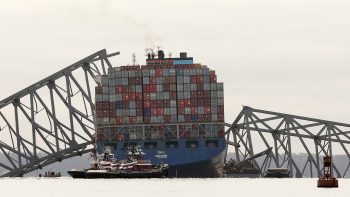Trucks wait at a port with little room to grow
More than 90 percent of global trade moves by ship. The Port of New York and New Jersey is the largest port on the East Coast (third largest after the ports of Los Angeles and Long Beach) and supports about 175,000 jobs in both states.
Truck driver Rafael Alvarez.
“Oh man, this is a mess,” Rafael Alvarez says. “This is pretty much like every day, living with the same thing. It’s getting worse.” Alvarez drives a truck for National Container Freight in New Jersey. Like most guys who get into trucking, he likes to drive, which as it turns out, is a shrinking part of the job these days.
“On a typical day, if you get lucky, you’re talking about like one to one and a half hours just to get in,” he says. “But over there, on the inside, let’s say it’s another one and a half to two hours. Pretty much you spend just like the whole day trying to make one move.”
Alvarez was sitting in a line of trucks over a mile long waiting to pick up containers at the Port of Newark.
Spending four to five hours just to pick up one load is not good. It translates into fewer deliveries and increased costs.
“You can’t back a train into a loading dock, so we’re the guy that delivers it the last mile,” says Tom Heimgartner, CEO of Best Transportation, which operates more than 100 trucks out of Newark. “A lot of our customers are doing basically just-in-time kind of thing; they don’t have large inventories. And when loads are late, it disrupts their whole supply chain.”
Heimgartner blames the backup on more containers coming through the port and too few longshoremen to do the work.
New Maseratis sit at the Port of Newark.
Others says the backup isn’t a manpower issue. “They can’t change the geography of the region, they can’t change the number of roads that go into and out of the port,” says Jim McNamara, spokesman for the International Longshoremen’s Association. And unlike say, airports, freeways or even your local bank, the Port of New York and New Jersey doesn’t operate on nights and weekends, at least not for loading trucks. McNamara also points out that unlike ports on the West Coast, New Jersey doesn’t have the space available to build out better port infrastructure. “You have a port in New York and New Jersey that is nestled between one of the largest airports in the country, Newark Liberty [International] Airport, and also right alongside the New Jersey Turnpike,” he says.
A more modern system for tracking and locating containers could help move trucks in and out faster, McNamara says. And, according to the New York Shipping Association, more than 650 new longshoremen have been hired since February.
There’s a lot happening in the world. Through it all, Marketplace is here for you.
You rely on Marketplace to break down the world’s events and tell you how it affects you in a fact-based, approachable way. We rely on your financial support to keep making that possible.
Your donation today powers the independent journalism that you rely on. For just $5/month, you can help sustain Marketplace so we can keep reporting on the things that matter to you.


















